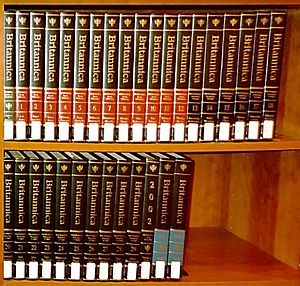Macropædia facts for kids
The Macropædia is a very important part of the Encyclopædia Britannica. It's like the main section of this famous encyclopedia. The name "Macropædia" comes from the word "macro," which means "big." So, you can think of it as the "big encyclopedia" part.
The Macropædia is known for its very detailed articles. Each article usually covers a large topic, giving you lots of information. This is different from the Micropædia, which has shorter, quicker articles.
What is the Macropædia?
The Macropædia is one of three main parts of the Encyclopædia Britannica. The other two parts are the 12-book Micropædia and the 1-book Propædia. The Macropædia itself has 17 books filled with knowledge.
It contains articles that go deep into subjects. For example, instead of just a quick definition, a Macropædia article might explain the history, different aspects, and important details of a big topic.
History and Changes
The Macropædia was first introduced in 1974. This was when the 15th edition of the Encyclopædia Britannica was released. Back then, it had 19 books and contained 4,207 articles.
Over time, the Britannica team made some changes to make it even better. In 1985, they combined and shortened many of these articles. This reduced the Macropædia to 17 books, but it still had about 700 very detailed articles.
These articles can be quite long. Some are as short as two pages, while others can be as long as 310 pages! The longest article ever was about the United States. It was created by combining 50 separate articles, one for each U.S. state.
The Macropædia is always being updated. New articles are added regularly. Older articles might be split into smaller ones, made shorter, combined with other articles, or even removed if they are no longer needed. This keeps the encyclopedia fresh and accurate.
See also
 In Spanish: Macropædia para niños
In Spanish: Macropædia para niños


